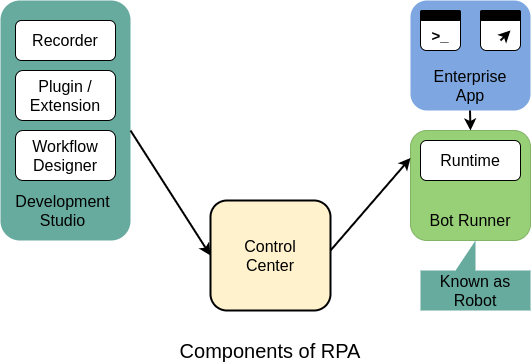Components of RPA
Robotic Process Automation includes some essential components that form the RPA platform. These components together help to automate repetitive and rule-based processes.
The core components of Robotic Process Automation are listed below:
- Recorder
- Development Studio
- Plugin/Extension
- Bot Runner
- Control Center

Let’s describe each of these components one by one:
Recorder
The recorder is one of the critical components of Robotic Process Automation. It adds an ability to automate web, desktop, and mainframe applications in a natural macro-like way without the need of any programming, coding or scripting.
Recorder in robotic automation uses an object recording approach as a primary mode. By default, RPA bots capture object properties, including their values of active elements throughout the recording. After the recording is complete, RPA bots find the same elements and repeat the process as they recorded. RPA robots perform actions such as click, hover, drag, or scroll, on the same elements during script execution. RPA Recorder also includes an option to modify the workflow and add the system actions manually. These actions may consist of opening applications, switching to a specific window, working with a clipboard, manipulating Excel files, etc.
Development Studio
Almost every RPA tool includes Development Studio in its core components. The Development Studio helps to design or develop intelligent process automation workflows. It allows you to get full control over the automation. It also allows you to install activities packages, wizards, recorders, and custom plugins.
Some typical features of RPA Developer Studio can be explained as below:
- Dashboard with GUI (Graphical User Interface).
- Different types of Recorders.
- Logging and Exception Handling.
- Integration support with OCR (Optical Character Reader).
- Collection of pre-built, drag-and-drop templates.
- Universal search option to search across all the automation resources such as libraries, activities, projects, etc.
Plugin/ Extension
Most of the RPA platforms consist of several plugins and extensions to perform easy development and execution. RPA plugins are the set of programs that can be installed along with the RPA tool. These plugins handle different types of tasks, such as extracting the data from invoices, manipulating the dates of different databases, or transcribing speech, etc. RPA plugins are beneficial as they reduce the development efforts, error rates, and implementation time. They can be directly used after they are installed along with the RPA tool.
Bot Runner
Bot Runners are used for executing the developed software bots. They are the machines on which bots are run or executed. Multiple bots can be assembled parallelly for faster execution. The only requirement to run the bots is ‘Run License’. The bots also report the execution status (i.e., execution logs, pass, or fail, etc.) back to the control center. Once a developer creates a software bot or task and further updates the status on the control room, the control room schedule and executes the bots on the bot runner. The serial of bot execution usually depends on the requirements or priorities.
Control Center
The control center is the most important component of any RPA tool. It is a web-based platform that is used to control the software bots created by the Bot Creator. It allows users to schedule, manage, control, and scale the activity of a vast amount of digital workforce. It also offers features such as centralized user management, automation deployment, source control, and a dashboard.
